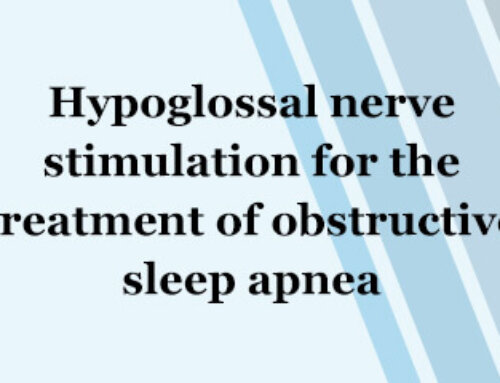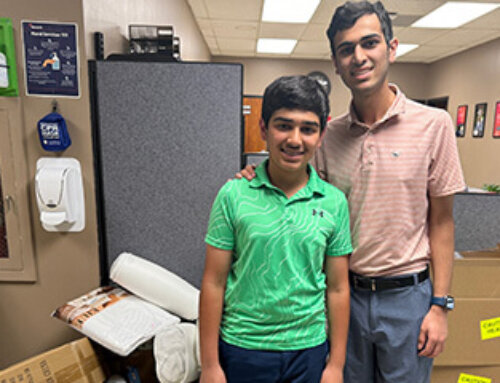
Diwakar Balachandran, MD, FAASM
MD Anderson Cancer Center
Professor, Department of Pulmonary Medicine, Division of Internal Medicine
An AASM member since 2002, Dr. Dwakar Balachandran specializes in pulmonary and sleep medicine. After learning about the tie between cancer-related fatigue and sleep, Dr. Balachandran joined the MD Anderson Cancer center team to further explore how MD Anderson could benefit from embedding a sleep center within the cancer center.
How did you become involved in the field of sleep medicine?
I first became acquainted with sleep medicine during my pulmonary critical care fellowship at the University of Chicago. The sleep fellows would bring cases to our pulmonary morning report, and it seemed fairly mysterious to me how they would take these tracings and charts and come up with diagnoses that could actually help our patients with respiratory disease. Also, during my residency at Beth Israel Deaconess Medical Center, I joined a one-year sleep fellowship under the direction of Dr. Robert Thomas. My good friend, Dr. Brian Murray, a neurologist in his preliminary year at Beth Israel, was enrolled in the fellowship, and he encouraged me to get involved in the program, too. I learned very quickly that there is a lot more to sleep medicine than just sleep apnea. I was fortunate that the program involved working with neurologists who introduced me to the neural control of sleep and the interaction between the brain and the respiratory system. I was also able to interact with notable leaders in the field such as Dr. Charles Czeisler, who gave me some of the first lectures in circadian rhythms and chronobiology, and Dr. Janet Mullington of Harvard Medical School, who was the primary investigator on a study that I participated in which involved sleep deprivation, inflammation, and immunity.
How did a sleep center become embedded in the University of Texas MD Anderson Cancer Center?
I moved to Houston, Texas in 2003, and initially was involved in academic sleep medicine at Baylor College of Medicine, which at that time was under the direction of Dr. Max Hirshkowitz. We had an opportunity to set up a new sleep lab to serve the needs of the disadvantaged community in Houston at one of the general hospitals within the Harris Health System. Soon after that, I heard of an interest to serve another underserved population in terms of sleep medicine – patients with cancer. This was in 2005 when little information had been generated on the possible benefits to these patients.
I approached Dr. Burton Dickey, chair of Pulmonary Medicine, to determine if MD Anderson would have an interest in a Sleep Center. He said that cancer-related fatigue (CRF) was a major topic in the cancer world, and he thought there could be some interactions to explore between CRF and sleep. This served as an impetus for me to further explore this unique opportunity. I met with multiple faculty members in Symptom Research, Pulmonary Medicine, Cardiology, Anesthesia, and Oncology who all saw this as a severely unmet need at MD Anderson. Given the excitement surrounding this, I decided to join the institution. Over my initial year here, my colleagues Dr. Lara Bashoura, Dr. Saadia Faiz, Leendert Keus and I worked to gain institutional support. Thankfully, we convinced senior and administrative leadership that improving sleep might have ramifications for the entire spectrum of cancer care, which includes cancer prevention, cancer treatment, and cancer survivorship.
For example, our data suggested that nurses who work rotating shifts and flight attendants on long-haul flights, both of whom may have circadian rhythm disturbances, are at a higher risk for breast cancer. We further explained how cancer treatments may lead to excessive daytime sleepiness, insomnia, and decreased quality of life. Additional data regarding chronobiology in the delivery of chemotherapy indicated how chemotherapy could be delivered more effectively, and with fewer side effects, depending on when it was given in the circadian cycle. And lastly, we showed how disturbed sleep compromised quality of life and outcomes in patients long after their cancer treatment – even when they are cancer free. It was these discussions that led MD Anderson leaders to a greater understanding on how a Sleep Center could play an important role in all aspects of cancer care.
From time to time, we’ve been called to further explain our goals in our institution’s mission of Making Cancer History®. A more recent revelation that obstructive sleep apnea increases cancer incidence as well as cancer mortality has served to further validate our importance to MD Anderson and the field of cancer.
What are the benefits – and challenges – associated with this model of care?
The benefits to our patients are very clear. Over the last 10 years, we’ve seen almost 4,000 patients with a variety of sleep disorders. Our database includes more than 4,000 polysomnograms in oncologic patients. This repository of data is something that we are only starting to tap into as we examine the etiology, incidence, and management of sleep disorders in cancer patients. The fact that we have a dedicated Sleep Center embedded within a comprehensive cancer center, offers us a unique opportunity to focus on these disorders. In particular, we are interested in understanding the connections between sleep and cancer, and most importantly, whether improving sleep and treating sleep disorders has a direct influence on cancer outcomes and survival.
The challenges include the inability to assess sleep disorders in busy oncologic practices. When the patient has cancer, obviously the focus must be the evaluation and management of that cancer. Because of this, we rarely have discussions with patients on other issues, such as sleep, until their situation becomes quite acute or severe. Through education and research, we hope to show that it is important to focus on these issues at the onset of cancer diagnosis, as we may be able to impact outcomes, such as quality of life and survival. As a comprehensive cancer center, our goal is to treat the whole patient and not just the cancer. The Sleep Center assists with this approach of patient-centered comprehensive cancer care.
What are the most prevalent sleep problems among your cancer patients?
In our experience and in our published work, we see a full spectrum of sleep disorders in patients with cancer. Insomnia remains the most common sleep disorder in cancer patients as it is in the general population. We find that patients with insomnia and generalized sleep disturbance often have symptoms that predate the diagnosis and can persist for several years after cancer diagnosis and treatment. Other studies have shown that up to 60%, or even 80%, of patients with cancer have insomnia. Cancer diagnosis is obviously an extreme precipitating factor for insomnia and there are many perpetuating factors that include changes in lifestyle and behavior, cancer treatments, and cancer symptoms such as nausea, vomiting and pain. All of these can make treating insomnia in cancer challenging. Fortunately, our experience and the literature suggests that treatment such as cognitive and behavioral therapy (CBT) for insomnia as well as medications can assist in the management of insomnia in cancer patients. We also collaborate in clinical trials with our colleagues in supportive cancer care, to look at therapies such as light therapy, exercise, and medications to treat insomnia in patients with cancer. Zolpidem remains one of the most commonly prescribed medications at our institution, and therefore it is incumbent upon us to define strategies to improve insomnia and sleep disturbance in our oncologic population.
Sleep-disordered breathing is also common in our cancer population. There are certain cancers in which the prevalence of sleep-disordered breathing may be as high as 80% and these include patients with cancers of the head and neck and possibly those with lung cancer. There are strong associations between sleep-disordered breathing and cancers such as melanoma. Central sleep apnea and sleep-related hypoventilation are more common in cancer patients who may be on opioid medications for cancer-related pain. Cheyne-Stokes breathing has been described in cancer patients who develop cardiomyopathy related to cardiotoxicity resulting from chemotherapy regimens. The field of sleep-disordered breathing in cancer has really come into its own in the last few years as we understand the underlying mechanisms by which sleep-disordered breathing, and in particular, the intermittent hypoxemia that often accompanies sleep-disordered breathing, may influence oncogenesis and the spread of cancer.
Limb movement disorder such as restless legs and periodic limb movement disorder also occur in cancer patients, especially in those who may have iron deficiency anemia as a result of cancer treatment or develop neuropathy as a result of certain chemotherapeutic agents.
We’ve also seen a few cases of parasomnias in our cancer patients, but we haven’t found that these are in anyway more common in our patient population. Unfortunately, we’ve even had a patient with acquired narcolepsy related to a brain tumor.
It is very exciting for us to go into sleep clinic, because we never know what will come through the door, but we know that we will likely experience a full gamut of sleep disorders and are excited by the opportunity to apply our knowledge as sleep physicians, as well as our familiarity with oncologic illness in the evaluation and management of these challenging patients.
Does the treatment of sleep disorders improve cancer care in your patients?
This is a very intriguing question. There have been reports, and we have seen for ourselves, where the treatment of sleep disorders improves quality of life and symptom control. Improved sleep quality will impact other cancer-related symptoms such as fatigue, pain and mood disturbance. Numerous studies have shown how treating cancer-related insomnia with CBT improves inflammation, which may have an effect on cancer and cancer-related symptoms. However, the Holy Grail will be to demonstrate that the treatment of sleep disorders, whether insomnia or sleep-disordered breathing, which are among the most common sleep disorders in cancer patients, will actually impact tumor growth, metastasis and mortality. Although there are studies that show that sleep apnea may actually worsen these outcomes, I don’t believe there are currently any studies that show that treating sleep disorders directly affects tumor growth, metastasis or mortality. These would be very important studies, and we are excited by the opportunity to further this knowledge based on our work here at MD Anderson in the Sleep Center. Our goal is to make sleep medicine an important tool in the management of patients with cancer, and I hope that, one day, sleep oncology will be another field that may impact the treatment of cancer.
Do you think that sleep centers could be embedded in other specialty settings (e.g., in heart centers)?
Our experiences have shown that there is a lot to be gained by having a Sleep Center within a targeted disease population. It allows for us to gain experience in the particular sleep disturbances and issues related to particular disease process. For instance, we have learned how certain cancer therapeutic agents may be more likely to cause insomnia and impact limb movement disorders by causing neuropathy.
I think this is a model that would certainly apply to other disease states such as heart disease, perioperative care, and psychiatric disease. Given the increased use of opioids in our general population with pain, understanding the interactions between sleep and pain control may be another important area of study.
We’ve been fortunate that we’ve been able to establish our Sleep Center to focus on the needs of oncologic patients. Over the last few years we’ve met many other practitioners in other cancer centers who have partnered with us in furthering the field of sleep oncology. More specialists across the globe who partner with us will certainly go a long way in identifying new ways of managing and treating these disorders.
This content was published in the Summer 2018 issue of Montage, the official membership publication of the American Academy of Sleep Medicine (AASM). To read more content from this issue, click the button below!




